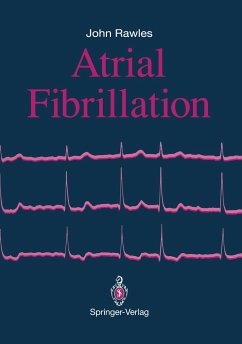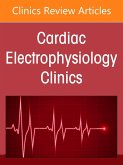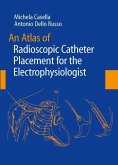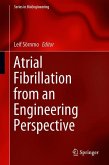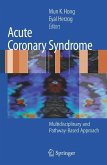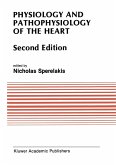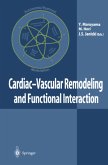John Rawles
Atrial Fibrillation
John Rawles
Atrial Fibrillation
- Broschiertes Buch
- Merkliste
- Auf die Merkliste
- Bewerten Bewerten
- Teilen
- Produkt teilen
- Produkterinnerung
- Produkterinnerung
Atrial fibrillation is a common and important arrythmia which affects nearly5% of peopple over 70. This synthesis of current knowledge which is based onmuch original work by the author brings togeher for the first time the many areas of advance in recent years and will help to make experts from the highly specialised fields within cardiology aware of the developments withinothers.
Andere Kunden interessierten sich auch für
![Atrial Fibrillation in Heart Failure, an Issue of Cardiac Electrophysiology Clinics Atrial Fibrillation in Heart Failure, an Issue of Cardiac Electrophysiology Clinics]() Atrial Fibrillation in Heart Failure, an Issue of Cardiac Electrophysiology Clinics61,99 €
Atrial Fibrillation in Heart Failure, an Issue of Cardiac Electrophysiology Clinics61,99 €![Atlas of 3D Echocardiography Atlas of 3D Echocardiography]() Edward A. GillAtlas of 3D Echocardiography199,99 €
Edward A. GillAtlas of 3D Echocardiography199,99 €![An Atlas of Radioscopic Catheter Placement for the Electrophysiologist An Atlas of Radioscopic Catheter Placement for the Electrophysiologist]() Michela Casella / Antonio Dello RussoAn Atlas of Radioscopic Catheter Placement for the Electrophysiologist186,99 €
Michela Casella / Antonio Dello RussoAn Atlas of Radioscopic Catheter Placement for the Electrophysiologist186,99 €![Atrial Fibrillation from an Engineering Perspective Atrial Fibrillation from an Engineering Perspective]() Atrial Fibrillation from an Engineering Perspective119,99 €
Atrial Fibrillation from an Engineering Perspective119,99 €![Acute Coronary Syndrome Acute Coronary Syndrome]() Mun K. Hong / Eyal Herzog (eds.)Acute Coronary Syndrome75,99 €
Mun K. Hong / Eyal Herzog (eds.)Acute Coronary Syndrome75,99 €![Physiology and Pathophysiology of the Heart Physiology and Pathophysiology of the Heart]() Physiology and Pathophysiology of the Heart39,99 €
Physiology and Pathophysiology of the Heart39,99 €![Cardiac-Vascular Remodeling and Functional Interaction Cardiac-Vascular Remodeling and Functional Interaction]() Cardiac-Vascular Remodeling and Functional Interaction38,99 €
Cardiac-Vascular Remodeling and Functional Interaction38,99 €-
-
-
Atrial fibrillation is a common and important arrythmia
which affects nearly5% of peopple over 70. This synthesis
of current knowledge which is based onmuch original work by
the author brings togeher for the first time the many areas
of advance in recent years and will help to make experts
from the highly specialised fields within cardiology aware
of the developments withinothers.
which affects nearly5% of peopple over 70. This synthesis
of current knowledge which is based onmuch original work by
the author brings togeher for the first time the many areas
of advance in recent years and will help to make experts
from the highly specialised fields within cardiology aware
of the developments withinothers.
Produktdetails
- Produktdetails
- Verlag: Springer / Springer London / Springer, Berlin
- Artikelnr. des Verlages: 978-1-4471-1900-5
- Softcover reprint of the original 1st ed. 1992
- Seitenzahl: 260
- Erscheinungstermin: 8. Dezember 2011
- Englisch
- Abmessung: 242mm x 170mm x 15mm
- Gewicht: 452g
- ISBN-13: 9781447119005
- ISBN-10: 1447119002
- Artikelnr.: 39502593
- Herstellerkennzeichnung
- Springer-Verlag GmbH
- Tiergartenstr. 17
- 69121 Heidelberg
- ProductSafety@springernature.com
- Verlag: Springer / Springer London / Springer, Berlin
- Artikelnr. des Verlages: 978-1-4471-1900-5
- Softcover reprint of the original 1st ed. 1992
- Seitenzahl: 260
- Erscheinungstermin: 8. Dezember 2011
- Englisch
- Abmessung: 242mm x 170mm x 15mm
- Gewicht: 452g
- ISBN-13: 9781447119005
- ISBN-10: 1447119002
- Artikelnr.: 39502593
- Herstellerkennzeichnung
- Springer-Verlag GmbH
- Tiergartenstr. 17
- 69121 Heidelberg
- ProductSafety@springernature.com
1 The Cardiac Conducting System and Its Autonomic Control.- Anatomy of the Conducting System.- Autonomic Innervation of the Heart.- 2 The Pathophysiology of Atrial Fibrillation.- Pathology.- The Electrophysiology of Atrial Fibrillation.- The Ventricular Response in Atrial Fibrillation.- The Role of the Autonomic Nervous System in Atrial Fibrillation.- Fibrillatory Waves in Atrial Fibrillation.- The Brody Phenomenon in Atrial Fibrillation.- The QT Interval in Atrial Fibrillation.- Atrial Fibrillation and the Wolff-Parkinson-White Syndrome.- Aberration in Atrial Fibrillation.- 3 Models of the Atrioventricular Node.- The Electrophysiological Model of the Atrioventricular Node.- Analogue Models of the Atrioventricular Node.- Mathematical Models of the Atrioventricular Node in Atrial Fibrillation.- The Atrioventricular Node as a Biological Oscillator.- More Electrophysiological Phenomena: Ventricular Extrasystoles.- Phase Resetting: An Achilles Heel.- 4 The Measurement of Cardiac Output in Sinus Rhythm and Atrial Fibrillation.- Assessment of Cardiac Function.- The Assessment of Cardiovascular Function.- Measuring Volumetric Cardiac Output by the Fick Method..- The Indirect Fick Technique.- Thermodilution.- Reproducibility of Thermodilution.- Measurement of Cardiac Output by Echocardiography and Doppler Ultrasound.- Linear Cardiac Output.- Expectations of Linear Cardiac Output.- Comparison between Thermodilution and Doppler Ultrasound.- Application of Linear Cardiac Output Measurement to Atrial Fibrillation.- Average Stroke and Minute Distance in Atrial Fibrillation.- Beat-to-Beat Measurement of Stroke Output.- 5 The Haemodynamics of Atrial Fibrillation: The Development of a Model of Left Ventricular Function.- The Relationship Between Time and Volume of the Pulse.- Derivation of a Mathematical Model of Left Ventricular Function.- The Physiological Basis for the Mathematical Model of Left Ventricular Function.- Application of the Mathematical Model of Left Ventricular Function.- Haemodynamic Consequences of Atrial Fibrillation.- Endocrine Consequences of Atrial Fibrillation.- 6 The Haemodynamics of Atrial Fibrillation: The Effect of Ventricular Rate on Cardiac Output.- Further Information from Multiple Regression Analysis.- The Ventricular Rate for Maximum Cardiac Output.- What is Meant by "Control" of Ventricular Rate?.- 7 The Use of the Haemodynamic Model of Atrial Fibrillation for Evaluating Drug Action.- More Haemodynamic Profiles.- Additional Haemodynamic Data Derived from Stroke Distance.- A Pilot Study of the Effect of Enoximone in Atrial Fibrillation.- A Placebo Controlled Trial of Enoximone and Digoxin in Atrial Fibrillation.- Conclusions.- 8 The Autonomic Control of Ventricular Rate in Atrial Fibrillation.- Respiratory Sinus Arrhythmia.- Measurement of Baroreflex Function.- A Systems Approach to Heart Rate Control.- Conclusions.- 9 Clinical Aspects of Atrial Fibrillation.- Epidemiology.- Aetiology.- Thromboembolism.- 10 The Management of Atrial Fibrillation.- Presentation.- Control of Ventricular Rate.- Cardioversion.- Chemical Cardioversion and Prevention of Atrial Fibrillation.- Anticoagulant Therapy.- The Wolff-Parkinson-White Syndrome.- New and Experimental Techniques in Atrial Fibrillation Pacing.- Appendix. A Simple Computer Model of the Electrophysiological System of the Heart, Considering the Sinoatrial and Atrioventricular Nodes as Sine Wave Oscillators.
1 The Cardiac Conducting System and Its Autonomic Control.- Anatomy of the Conducting System.- Autonomic Innervation of the Heart.- 2 The Pathophysiology of Atrial Fibrillation.- Pathology.- The Electrophysiology of Atrial Fibrillation.- The Ventricular Response in Atrial Fibrillation.- The Role of the Autonomic Nervous System in Atrial Fibrillation.- Fibrillatory Waves in Atrial Fibrillation.- The Brody Phenomenon in Atrial Fibrillation.- The QT Interval in Atrial Fibrillation.- Atrial Fibrillation and the Wolff-Parkinson-White Syndrome.- Aberration in Atrial Fibrillation.- 3 Models of the Atrioventricular Node.- The Electrophysiological Model of the Atrioventricular Node.- Analogue Models of the Atrioventricular Node.- Mathematical Models of the Atrioventricular Node in Atrial Fibrillation.- The Atrioventricular Node as a Biological Oscillator.- More Electrophysiological Phenomena: Ventricular Extrasystoles.- Phase Resetting: An Achilles Heel.- 4 The Measurement of Cardiac Output in Sinus Rhythm and Atrial Fibrillation.- Assessment of Cardiac Function.- The Assessment of Cardiovascular Function.- Measuring Volumetric Cardiac Output by the Fick Method..- The Indirect Fick Technique.- Thermodilution.- Reproducibility of Thermodilution.- Measurement of Cardiac Output by Echocardiography and Doppler Ultrasound.- Linear Cardiac Output.- Expectations of Linear Cardiac Output.- Comparison between Thermodilution and Doppler Ultrasound.- Application of Linear Cardiac Output Measurement to Atrial Fibrillation.- Average Stroke and Minute Distance in Atrial Fibrillation.- Beat-to-Beat Measurement of Stroke Output.- 5 The Haemodynamics of Atrial Fibrillation: The Development of a Model of Left Ventricular Function.- The Relationship Between Time and Volume of the Pulse.- Derivation of a Mathematical Model of Left Ventricular Function.- The Physiological Basis for the Mathematical Model of Left Ventricular Function.- Application of the Mathematical Model of Left Ventricular Function.- Haemodynamic Consequences of Atrial Fibrillation.- Endocrine Consequences of Atrial Fibrillation.- 6 The Haemodynamics of Atrial Fibrillation: The Effect of Ventricular Rate on Cardiac Output.- Further Information from Multiple Regression Analysis.- The Ventricular Rate for Maximum Cardiac Output.- What is Meant by "Control" of Ventricular Rate?.- 7 The Use of the Haemodynamic Model of Atrial Fibrillation for Evaluating Drug Action.- More Haemodynamic Profiles.- Additional Haemodynamic Data Derived from Stroke Distance.- A Pilot Study of the Effect of Enoximone in Atrial Fibrillation.- A Placebo Controlled Trial of Enoximone and Digoxin in Atrial Fibrillation.- Conclusions.- 8 The Autonomic Control of Ventricular Rate in Atrial Fibrillation.- Respiratory Sinus Arrhythmia.- Measurement of Baroreflex Function.- A Systems Approach to Heart Rate Control.- Conclusions.- 9 Clinical Aspects of Atrial Fibrillation.- Epidemiology.- Aetiology.- Thromboembolism.- 10 The Management of Atrial Fibrillation.- Presentation.- Control of Ventricular Rate.- Cardioversion.- Chemical Cardioversion and Prevention of Atrial Fibrillation.- Anticoagulant Therapy.- The Wolff-Parkinson-White Syndrome.- New and Experimental Techniques in Atrial Fibrillation Pacing.- Appendix. A Simple Computer Model of the Electrophysiological System of the Heart, Considering the Sinoatrial and Atrioventricular Nodes as Sine Wave Oscillators.

